THOUGHTFUL EATING
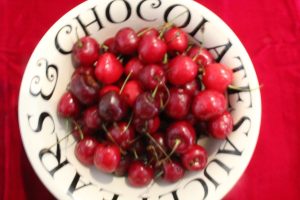

Disrupted food distribution this year has highlighted the amount of food Australia exports and imports. We have benefited from local asparagus, prawns, cherries and crayfish being readily available at good prices. A lot of our seafood, harvested from clean waters, is sent to Asia. But what is more disturbing is the amount of imported food we have and the impact of that on the countries producing these foods.
Earlier this week I was reading Nat Locke’s Opinion column in The Sunday Times Magazine (8/11) and was reminded of some of these imported food facts. Quinoa, that beloved superfood, has been eaten by the indigenous people of Peru, Chile and Bolivia, Argentina and Ecuador for thousands of years. The Western passion for this seed has driven up the price to the point where the locals can no longer afford to buy it. It is cheaper to buy junk food. Land used exclusively to produce quinoa has eliminated diversity and totally changed the diet of these people.


Keen on coconut milk for your curry, as a plant milk alternative or protein ball snack? Well, much of it comes from Thailand where monkeys are captured in the wild and forced to pick thousands of coconuts a day. Training a monkey to pick coconuts is a brutal process, too. Milks from Brazil, Colombia and Hawaii are usually harvested by tractor mounted hydraulic elevators or humans on ladders. Check the label then look online for more information.
There’s a problem with almond milk, too. Eighty percent of the world’s almonds come from drought-ridden California and require enormous amounts of water to grow. On top of that, we should consider the carbon footprint involved in getting them to Australia. Look for almond products from Australia. We now are the second largest almond grower in the world.
CHOCOLATE STRAWBERRIES
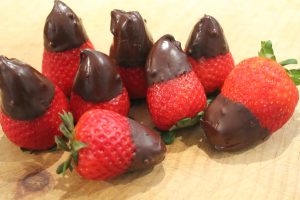

I’ve been working all this week and felt pretty time poor but also wanted to make a little treat for a dear neighbour to celebrate her birthday. Strawberries are plentiful here and I had some 80% cocoa dark chocolate in the cupboard so decided to try making Chocolate Dipped Strawberries. I’ve never done this before but found easy directions online.
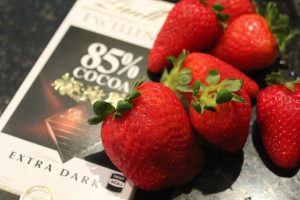

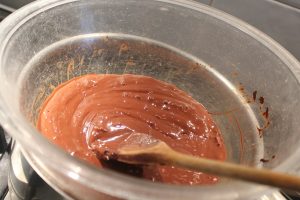

While I waited for 150gm of broken up chocolate to melt over boiling water I gently washed and dried a punnet of strawberries. I made sure the boiling water didn’t touch the bowl with the chocolate. Stirred regularly. When the chocolate was melted, I simply dipped the strawberry, using the stem as a handle, into the hot chocolate and rotated to cover it evenly.
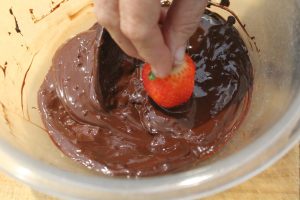

I allowed a brief drying time then set the strawberry on a sheet of baking/parchment paper on a baking tray. Some sat well on their tops, some leaned against each other and some fell over, but they all set well.


I left them in the fridge to firm up until that evening. I made a little “bowl” using the saved lid from a cardboard cylinder. I lined it with paper towel, arranged the dipped strawberries then tied it in cellophane. Added a rose to the ribbon and took it next door!
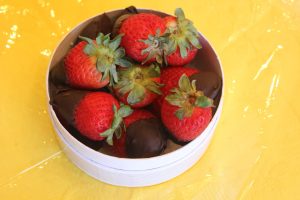

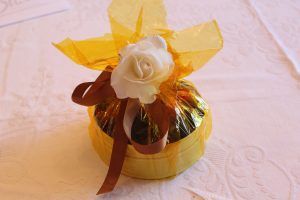

Leftover chocolate and another punnet of strawberries became my husband’s dessert that evening. I reheated the chocolate in the microwave, firstly for 30 seconds and then for 20 and it was perfect.
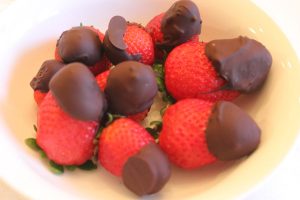

Quick, delicious and pretty. And fairly healthy, too.
CHRISTMAS CAKES
The fruit for these cakes was put to macerate in brandy mid October so it was time to make this year’s Christmas Cakes. Fruitcakes seem to divide the masses; some people love them, some people don’t like them at all, but most of us really, really like them! Soaking the fruit and then making and storing the cakes to mature is very much part of my family’s traditional Christmas planning, a tradition which may die with our son who doesn’t like fruitcake at all.
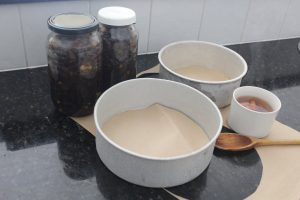

I use a double layer of thick brown paper and then baking/parchment paper to line the cake tins. This ensures slow, even cooking of the dense cake mixture. The almonds are blanched, ready to decorate the top of the cake along with some glacé cherries. In the past I’d roll out and carefully apply a layer of marzipan over apricot jam topped off with a thick layer of white icing. So much fiddling, so much sugar. My mother always decorated with almonds as we had an almond tree in the garden, and now I make a pattern of almonds and cherries pressed into place before the cakes go in the oven, too.
ti 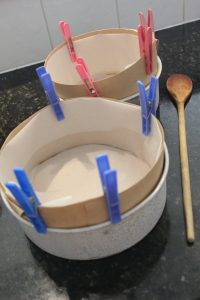

All held in place using one of my favourite tools, pegs! They are removed after the first spoonful of mixture holds the paper lining in place.
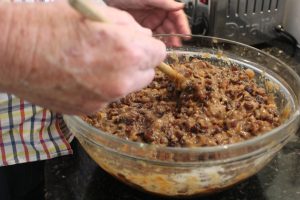

Mixing, enjoying the scent of brandied fruit, cinnamon, ginger, cloves, nutmeg, almond essence and vanilla essence. We both made a wish, then into a slow oven for about three hours.
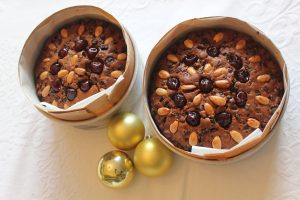

Left the cakes in the tins in the oven until the oven was cool and then put under a tea towel on the bench to completely cool overnight. Slow cooling prevents cracks on the top.
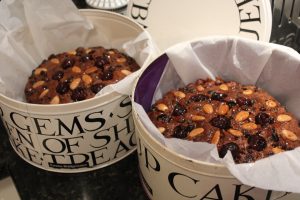

In tins and into the cupboard to mature. A little drizzle of brandy every few days adds to their richness.
REMEMBRANCE DAY in AUSTRALIA

On the 11th of November Australians commemorate Remembrance Day. This day has been observed in Commonwealth member states since the end of WW1. At 11 AM on 11th November 1918 the guns on the Western Front fell silent after four years of continuous warfare.
Since 1920 Australians pause at 11 AM for one minutes silence to remember those who have died in all conflicts and peace operations around the world.


In Perth the official Remembrance Day service is held at the War Memorial in Kings Park, high on the escarpment above the City. Buglers at each main intersection in the CBD sound out The Last Post in synchronization with the Kings Park bugler just before the Minutes Silence. When I was a small child all the traffic halted and men stood to attention with their hats off and in classrooms the children all stood by their desks. World War I touched Australia in a way that our other wars haven’t. Nearly all our fit men aged 18 to 40 went, so almost everyone’s grandfather and father was an ex serviceman. Red poppies have been a symbol of commemoration since 1920. Poppies were the first plants to bloom on Flanders Field in Northern France and Belgium.
